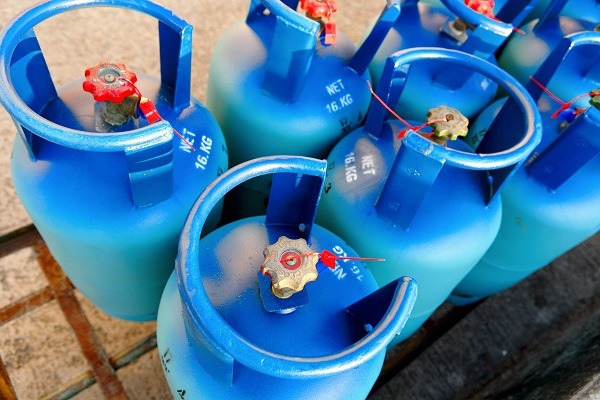Also known as liquified petroleum gas (LPG), propane is a colorless, odorless, and non-toxic gas. A by-product of petroleum refining and natural gas processing, it’s a safe and clean source of energy. It’s also highly efficient and affordable, which makes propane a great choice to use for heating homes. Moreover, it’s a versatile and clean-burning fuel. It’s not a greenhouse gas, and what’s more, the U.S. has plenty of it; approximately 97% of the propane used in the country comes from North America.
Propane is usually compressed and turned into liquid. For ease of delivery to consumers, it’s stored in tanks of different sizes. In the United States, propane is typically used as a fuel, especially in some parts of the country where the natural gas supply is scarce. Propane’s use, however, is seasonal. Consumption is at its peak during the autumn and winter months.
How Is Propane Used In Homes?
Aside from heating, American homes use this gas to power their household appliances such as air-conditioning, water heaters, cooking stoves, refrigerators, driers, lights, and others. Families that use propane as a main source of energy generally store propane in large tanks outside their homes. Propane companies, like Great Valley Propane, deliver the gas by using trucks, which can also fill the tanks as often as needed.
These large residential propane tanks hold about 500 to 1,000 gallons of fuel. Many backyard cooks also use portable tanks to fuel their grills. There are also a significant number of mobile homes that use propane for heating. Also, RVs (recreational vehicles) typically use propane to power their appliances such as refrigerators, water heaters, stoves, and others.
Propane Tanks Safety Tips
Propane is a highly inflammable gas, but the safety devices attached to propane tanks ensure that it’s safe to use. You might be thinking, “can propane tanks explode?” Well, yes—anything in the world can explode, really, if you think about it. But it would take several things to go wrong simultaneously for something like that to happen to a propane tank. Taking care of your propane tank properly and following safety tips would reduce that possibility to practically zero.
If you’re planning to use propane in your home, know these few safety tips when handling propane tanks:
1. Check Your Tanks Regularly
When not in use, turn your tanks off. Don’t keep any inflammable items near your tanks. Any unused appliances that are hooked to the tanks should be disconnected and stored away, too. As a precaution, install a gas detector that would warn you of any carbon dioxide or propane leaks. Since propane itself is odorless, manufacturers add mercaptan, which is a chemical that gives propane that rotten egg odor.
So, if you smell rotten eggs near a propane tank, turn the tank’s valve off and don’t light a match until the air’s cleared of the gas. If the odor’s still there, use a wet cloth to cover the tank. Call the local fire department promptly and wait for the firemen outside your home.
2. Make Sure Propane Tanks Are Safely Stored
Propane tanks should never be stored in an area where the temperature can reach more than 120ºF (49ºC). In colder months, take care that the tanks’ temperature doesn’t go below -40ºF (-40ºC).
Additionally, don’t store tanks in direct sunlight nor should you store them in any way other than in an upright position. Store your propane tanks outside your home, and don’t keep them in enclosed spaces. You can click here to learn more about the safe handling of propane tanks.
3. Use Propane Appliances With Care
Propane grills should never be used indoors. Using propane ovens, grills, or stoves as space heaters are never a good idea. In fact, it can be downright dangerous. Use your propane appliances for their intended purpose only.
One way to make sure that your appliances are safely connected to your propane tank is to work with a qualified service technician. Have the technician assess the safety of the appliances and have them check for any leaks.
4. Use Propane Tanks Safely
Always check for leaks after using a new propane tank. If you want to make sure that there aren’t any leaks, use a solution of detergent or soap dissolved in water. Wet a washcloth with the solution. Use it to wipe the rubber tubing. If bubbles are formed on the rubber tubing, it means there’s a leak.
Replace a leaky rubber tubing and don’t bother to ‘Macgyver’ it. Just buy a replacement instead. The same goes for regulators, valves, and other appliance parts.
5. Learn How To Transport Propane Tanks Safely
If, for any reason, you have to transport a propane tank, learn how to do it safely. Remember to secure the tank in an upright position. Use a rope to secure the tank. Don’t use metal chains; metal striking another metal could cause sparks. Don’t transport the tanks in a vehicle with closed windows. Keep the windows open as added security.
Don’t forget to lock and cover the tank’s valve with a dust cap. Tanks for refilling should be brought to a proper filling station.
Final Thoughts
Propane tanks are sturdy and have built-in safety features to ensure it’s safe to use. However, as a consumer, it’s important to know how to properly handle propane tanks. Propane is a gas that’s clean and affordable, and if you know how to take care of it, it’s safe and convenient to use.

